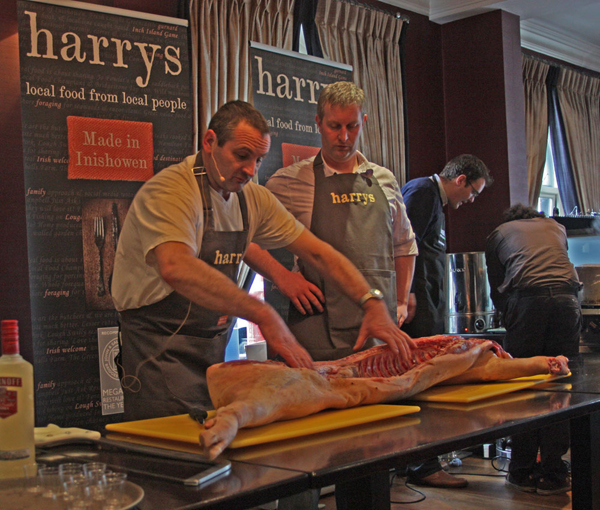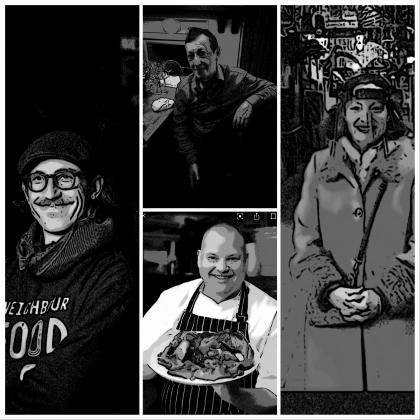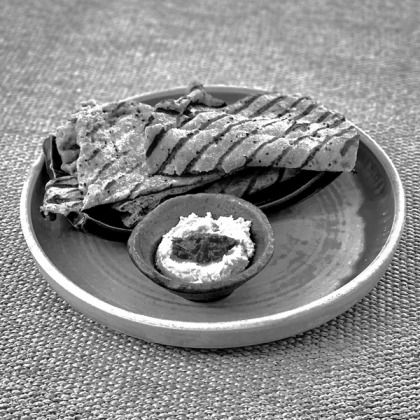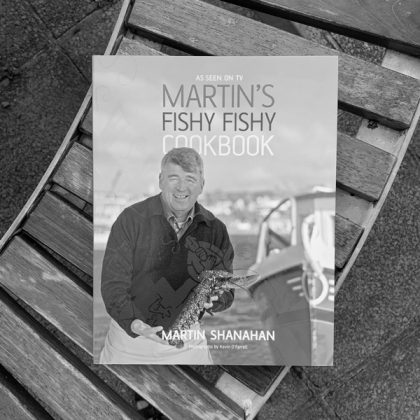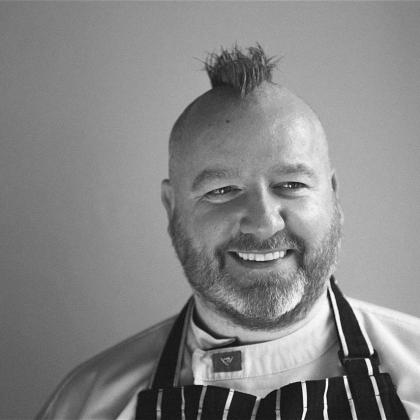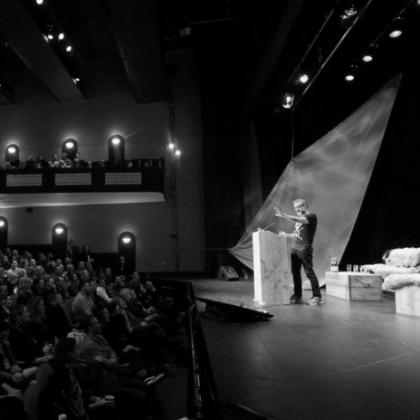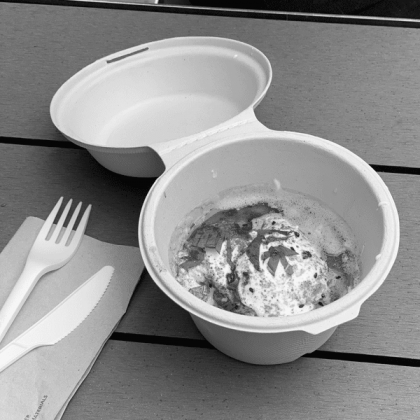Inishfood began with the outrageous idea that you could hold back the impending snow and sleet and serve pizzas -outside - in Donegal, to forty or fifty people, cooked by an amateur chef from his home-built garden oven.
How could that possibly work? It couldn't. Could it?
Well it did. Darren Bradley performed something of a miracle, not only in cooking up pizza perfection for so many, but holding back the weather as well. There was a marquee, but it was warm and hospitable enough to stay in the garden. In Inishowen. In March. He was assisted by elderly neighbour Jack Doherty, who scooped the pizzas from the oven, and parted the crowd with his peel as he, again and again, delivered perfectly made pizzas. The next morning the hills were covered with snow.
That was the beginning of the food blogger's festival that is Inishfood. A celebration of local Irish food for people who love it. Inishfood was organized by Donal of Harry's Restaurant in Bridgend and Kristen and Caroline from the Irish Food Bloggers Association.
Here is a report of some of the events.
L. Mulligan Grocer, Beer Tasting (www.lmulligangrocer.com)
The first beer we tasted was Belfast Blonde, made by the Hilden Brewing Company.
Belfast Blonde is an ale, but, explains Colin Hession, "it drinks like a lager". The difference between an ale and a lager, I am given to understand by the dynamic duo behind L. Mulligan Grocer, is in the yeast. An ale ferments in a different way from a lager because of the different yeast, with the lager fermenting from the bottom up. This is why lagers sparkle, with bubbles rising from the bottom of the glass. Belfast Blonde, despite being an ale, drinks like this. It's straw colored and zesty, with what Colin describes as "candy cane" flavors. "Its citric flavors make it particularly good with seafood" explains Seaneen Sullivan, Colin's partner. "We love it with paella".
Copper Coast was next up, made by the Dungarvan Brewery. Copper Coast is a bottle conditioned Irish red ale. What this means is that it undergoes a second fermentation, which happens in the bottle. This little extra fermentation, which only takes a few weeks to happen, gives the beer a bit more body, adding more carbonation, and more alcohol.
Because the yeast is left in the bottle, the beer is slightly cloudy. It is unfiltered, which gives it a delicious sediment. The Mulligan team describe this beer as "gentle".
The third and final beer we tried was Dark Arts, made by Trouble Brewing in Kildare. This was a big hit with the pizza-eating crowd with its boozy fruit flavours. "Creamy, not thin, but light" is how Colin described it. This is a beer to cook with "everything from lamb carbonade to Christmas pudding" says Seaneen. It's also a drink that goes with chocolate.
Colin likes to describe this beer as tasting like "chocolate bread and butter pudding with creme anglaise".
"I love describing it like that. There is so much to beer. It's so personal."
Coffee Masterclass with Juan Cuesta from Coffee Angel and Ross Kane from Bailies (www.coffeeangel.com www.bailiescoffee.com)
This part of the festival was presented by Bailies' Coffee Roasters, a local micro roastery from Belfast, and Coffee Angel from Dublin. Bailies source single estate coffee direct from their suppliers, Coffee Angel use their coffees in the shops in Dublin.
"Coffee is a fruit" explained Juan in his delicious Spanish dialect, "and it undergoes a long process to get this bean to become fancy".
It is up to the roaster, says Ross from Bailies' Coffee, to keep the characteristics of the bean. "South American beans are sweet and fruity, African beans are more floral." For the talk at Inishfood they demonstrated how to make the best cup of coffee from a cafetiere, a paper filter, and an airopress.
For both the cafetiere and the filter coffee the ratio of coffee to water was 60g per litre. Each time the coffee was made, it was carefully weighed, essential, they insist, to always making the perfect cup of coffee.
The moment coffee is ground, it begins to go stale, losing 50% of its aromatic properties in the first hour after it has been ground. This is why they stressed the need for a home grinder. And if you are buying a grinder, make sure it is adjustable, and can grind the beans to different grades. A cafetiere needs a coarse grain, and the coffee made from one of the French machines produces a strong cup with a kick. This is because the oils from the beans are allowed to stay in the water. The filter, on the other hand, requires a finer grind. Here, the oils are filtered off, producing a coffee that is cleaner and more acidic. Almost more like drinking a tea.
When making the coffee in the cafetiere, place the coffee in the jug. Pour the water on in one go and leave for precisely four minutes. Press down the plunger and pour the coffee into another pot. Otherwise it will keep brewing and become bitter.
For making the filter coffee, first wet the paper "to get rid of the paper flavor" explains Juan. Also, warm the jug. Once again, measure your finely ground coffee and place in the paper. Carefully pour the water into the filter, taking a little time to pour it. Juan didn't pour from the middle, but circulated the water around the sides of the filter paper. The water should have gone through the filter in around 3 minutes. If it takes longer, you need to grind the beans finer.
The final coffee machine Juan demonstrated was an Aeropress, which is a coffee machine invented by the man, Alan Adler, who invented the frisbee. You can use this machine to make either an espresso-type coffee, or something similar to filter coffee. Juan made a filter-style coffee using proportions 14g to 200mls of coffee. Use more coffee, very finely ground to make the espresso.
The Three Butchers
The next talk was a delight to watch. Ed Hick, from Dublin, TJ Crowe, from Tipperary and Jack McCarthy from North Cork demonstrated how to cut up a pig, and how to make black pudding.
Jack (Sir Jack, of course) told us about his award-winning puddings, including the chocolate chip, mint and pistachio pudding he had invented for dinner that night in Harrys. (Chef Raymond paired it with venison, and the combination was something else!) Jack had also invented an Irish haggis flavored with Inishowen whiskey for the event.
What I loved about this talk were the little words of wisdom that Ed Hick constantly came out with:
We are the only animal that actually enjoys the taste of salt. This is why salt is a good preservative - it keeps the pests away.
If you can tolerate green and white mould on cheese, why do you get anxious when you see it on bacon.
Your nose is three quarters of an inch from your mouth for a reason. It's your last line of defence to stop you eating something that may no longer be good.
Ed finished the talk by encouraging all of us to try the uncooked blood pudding mixture. "You've tasted blood before, he said, either on the handlebars of your bicycle, or the last time you cut yourself with a sharp knife."
Farmhouse buttermaking
This talk was hosted by Imen McDonnell assisted by Ella MacSweeney. I think everybody in the room will go home and make butter. It was so easy and delicious and, as Imen says, what lovely gifts it makes.
The process goes like this. Take 500ml cream, pour into an electric mixer. Put the mixer on high. Beat the cream until it collapses and the butter separates. Stop as soon as this separation happens, and pour, through butter muslin, into a bowl. Squeeze the butter with the muslin. You really need to squeeze all the buttermilk out, otherwise it will quickly turn the butter rancid.
The by-product of the buttermilk can be simply drunk, used to make bread, and apparently it also makes a great stain remover.
When you have squeezed out as much buttermilk as you can, place the butter back in the electric mixer and beat again for about 30 seconds. This will release a little more buttermilk. Squeeze again through the muslin. Finally, to get out the very last of the buttermilk, place the butter into a bowl of iced water, and knead to squeeze our the final liquid (you can use butter paddles for this).
You now have your butter, which at this stage can be salted and flavored. Good flavoring ingredients include garlic, honey, herbs and lemon.
Ella McSweeney explained the difference between this, fresh creamery butter, and "country butter". The latter is made from slightly fermented milk, and has a stronger flavor. Just leave the cream on the worktop in a jug for up to 24 hours to make the country butter version.
Farmhouse Cheesemaking
The final talk of the day was given by David Tiernan from Glebe Brethan Cheese and Tiernan Family Farm Milk. David's raw milk, now available in some specialist shops, and even coffee shops is one of those products that sells out minutes after it hits the shelves.
David's cheese is Glebe Brethan, and if ever there was a cheese that displays the character of the person who invented it, it is this cheese. Modest, deep, accessible, full of goodness, the cheese certainly reflected the wise David, whose talk was simple and effective.
"Your cheese is only as good as your milk, and milk is only as good as what your cow eats." David Tiernan keeps a record of every cheese he makes. "Every one is different, and it depends on what humor the cow might be in, which field she might be grazing and what the weather is doing."
The cheese we sampled was 18 months old "a quick maturing cheese has no depth of flavor, no after taste."
David ended the session saying "If every restaurant in County Louth used just 2kg of my cheese per month, I couldn't even make enough to supply them. They don't, and I would like to know why?"
This was a good point on which to end the practical sessions, for this was what Inishfood was effectively exploring. The use of local foods by local restaurants and shops. Donal Doherty has made this the core of his philosophy for Harry's. And the restaurant is experiencing double digit growth in the midst of a recession.
Harry's celebrates things like butter, coffee, beef and pork, and of course, cheese. Surely it's not outside the capabilities of every restaurant in Ireland to look again at these core ingredients and celebrate them in the way they were celebrated at Inishfood.

